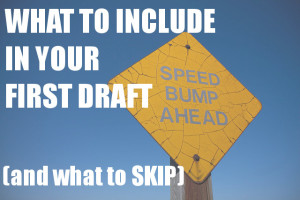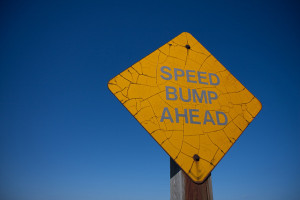The “experts” say your first draft should be quick and rough, and that you fix it in later drafts. But when I first started writing, I didn’t get that. Why should I waste time writing a “rough” draft that I’ll have to correct later? Why not just take the time to make it perfect the first time around?
No. No. Nonononono.
If you’ve written anything longer than flash fiction, you probably know why this attitude is a problem: Part of fiction is planned – but part is discovery. As you work your way through the story, your characters and plot will change. So if you try to write in “final draft form,” you’ll waste precious time agonizing over just the right word – when you may end up cutting the entire chapter later.
But where do you draw the line? What do you spend time on in the first draft, and what do you save for later? Here’s what I’ve learned over the years.
The Rule of Thumb for Your First Draft
Write as well and in as much detail as you naturally can in the moment. Skip over whatever slows you down.
What that Means
Don’t intentionally make it sloppy.
This may sound obvious to you, but as a young writer, I interpreted “first drafts are terrible” as “you should only worry about what happens, not how it sounds.” But it’s not about discarding grammar and style. It’s about writing what comes naturally to you in the moment. Make each sentence sound as good as you can without losing the momentum of the scene. Speaking of which:
Keep your momentum.
First drafts aren’t about speed; they’re about momentum. Momentum is usually driven by action and dialogue, so focus on those, but don’t be chained by them. If a description flows out of you naturally, write the heck out of it. But if you’re struggling – maybe you just can’t picture the setting, or maybe you need to do a little botanical research – skip over it. Which brings us to:
When you hit a speed bump, flag it and move on.
If you come across a speed bump, do not stop to fix it. You’ll lose momentum, and end up spending hours doing research for one tiny detail. Write a placeholder note and move on. I use all caps because they’re easy to type and to see. So, for instance, if I can’t think of the right word to describe something, I’ll just write ADJECTIVE where the word should go.
Speed bumps can include:
- Names of places and minor characters
- Descriptions
- Tricky sentences
- Tricky transitions between scenes
- Single words you just can’t think of
- Translations if you’re using a foreign or made-up language (I write the dialogue in English, and go back and write the actual language later)
Just remember – only skip these things if they aren’t coming to you naturally.
Know the difference between speed bumps and plot issues.
Speed bumps are details that don’t affect the plot. Ignore them. Plot, on the other hand, is tide-changing. The trickiest area here will be research – deciding how much time to research before moving on. For instance:
- Don’t spend hours researching semiautomatics to determine what gun your hero carries. That’s a speed bump. Write “He drew his GUN TYPE.” and move on.
- Do spend five minutes researching how many rounds the average magazine holds so you know roughly how many shots he has in that big action sequence. That’s a plot issue.
Use your writer’s block.
Say you’re blocked trying to write dialogue. You probably don’t want to skip over that, because it can affect the trajectory of the story. Instead, take a break to look back at your flags, like the descriptions and transitions, and work on one of those. By working on a character description, for instance, you might find some inspiration for his dialogue.
Group similar tasks together.
Pretty much any list of organizational tips will tell you this. Every time you jump between tasks, it takes time to reset your brain. Minimize this time by grouping similar tasks together. So when you’re getting near your final draft, comb through and do all the character names at once. Then, do all the translations. And so on.
–
If I had known this method when I started writing, I would have saved so much time. Every writer and every story is different, but the same basic rules of thumb apply.
What are your time-saving tips for writing?
—

What to include in your first draft – and what to skip




Inspiring bullet points. I once wrote a first draft that was 240k words long. I got it down to 83,000 in the end but that was one heck of a painful weekend!
Keep up the good work
Nick
That’s quite an accomplishment – especially in only one weekend!
*sigh* This is something that has never been easy for me… I guess that’s why speed has never been one of my strong-suits. But I can’t argue with the logic of it. I think the approach outlined here is probably much more effective than my methodical back and forth.
I don’t seem to be much good at growing a story and then going back and refining it. I want to build it from the ground up like a house, rather than work the whole like a painting. But that doesn’t stop me from thinking that I’d probably be better off treating it like a painting.
One possible advantage of the slow way is that when writer’s block hits, I can go back and read for inspiration, the fruits of the refining process motivate me. But I guess that is simply an argument for making sure that, as you say, the rough draft is as good as you can make it. If one does that, then there should still be enough gems uncovered to provide motivation.
Anyway, great post! You boil it down well without losing the important points. That will make it easier for me to keep it in mind as I go on from here.
Yeah, I’ve only started using this method in the most recent rewrite. It seems to be helping a lot. But I think “rough draft” is kind of a misnomer, because it does sound like something sloppy. I do take the time to really flesh each sentence if I’m in a good flow, so there’s stuff I can go back and read for inspiration, and stuff that will likely make it into the final draft. I’ve just given myself permission to skip the things that are tripping me up.
I’m a bit of a “perfectionist” when it comes to writing…and perhaps that’s why I haven’t been able to write anything significant of a longer length. Your points may be helpful…I shall try to “write what comes” and then make it perfect later, rather than trying to make it perfect now and then giving up entirely on figuring out what comes next.
It has certainly helped me!
usually I find these lists too specific for a ‘if you write like me, here are some tips for how you have to write’. But this is useful – great ideas for getting through the things that slow down your writing 🙂
What advice do you have for a first-time NaNoWriMo noob. It starts tomorrow and I’m taking the plunge.
Well, first of all, congratulations on your courage for signing up! I’ve never been brave enough to attempt NaNo myself (it doesn’t help that I write for a living, and would be burned out for my real job within the first few days. Sigh). But the post above should help you a lot with keeping your momentum going. So will a detailed plot planned ahead of time.
Part of plotting that helps me is breaking the story up into parts, like a three-act play. Divide your plot up so you know what happens in the beginning, when you’re introducing characters, setting, and situation; the middle, when you’re increasing tension; and the end when you have the climax and denouement. Somehow it helps me wrap my head around the story better when I break up the scenes in parts like that (I like to write all the scenes and elements I know I’ll need on note cards and arrange them in order on a cork board).
If you get stuck when writing, that’s an opportunity to go back and fill in the blanks. Write detailed descriptions of all your settings and characters. Jump back and write flashbacks from characters’ childhoods. Jump forward and write an exciting scene you’ve been saving for later. Some things, like excessive description, may be cut in the final draft, but (1) it’ll raise your wordcount and (2) it’ll be good practice.
Good luck!
Great article and points to follow. I didn’t understand how to get past roadblocks until I read this.